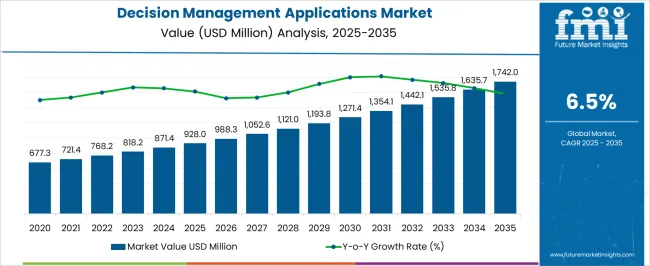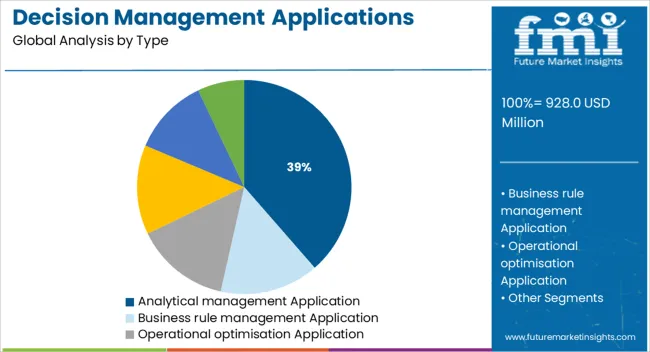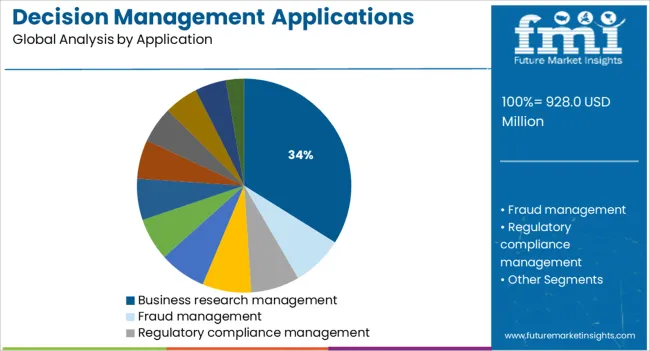The Decision Management Applications Market is estimated to be valued at USD 928.0 million in 2025 and is projected to reach USD 1742.0 million by 2035, registering a compound annual growth rate (CAGR) of 6.5% over the forecast period.

| Metric | Value |
|---|---|
| Decision Management Applications Market Estimated Value in (2025 E) | USD 928.0 million |
| Decision Management Applications Market Forecast Value in (2035 F) | USD 1742.0 million |
| Forecast CAGR (2025 to 2035) | 6.5% |
The decision management applications market is experiencing sustained momentum due to the growing need for real time decision support, data driven operational intelligence, and seamless integration of analytics into enterprise workflows. Organizations are increasingly investing in platforms that enhance automation, minimize decision latency, and streamline business rules across functions such as finance, operations, marketing, and customer service.
Advancements in artificial intelligence, machine learning, and cloud based computing are accelerating adoption of decision management systems that enable predictive and prescriptive insights. The demand for agile decisioning tools is also being driven by regulatory complexity, dynamic market conditions, and competitive pressure to optimize performance outcomes.
As businesses shift toward proactive and insight led management models, the decision management applications market is set to expand across both large scale enterprises and agile digital first organizations.
The market is segmented by Type and Application and region. By Type, the market is divided into Analytical management Application, Business rule management Application, Operational optimisation Application, Testing management Application, Workflow management Application, and Monitoring & governance Application. In terms of Application, the market is classified into Business research management, Fraud management, Regulatory compliance management, Accounting and revenue management, Human resource management, Credit risk management, Customer management, Business intelligence and analytics, Cross-sell and up-sell, Web-based purchasing, Single channel management, and Multichannel management. Regionally, the market is classified into North America, Latin America, Western Europe, Eastern Europe, Balkan & Baltic Countries, Russia & Belarus, Central Asia, East Asia, South Asia & Pacific, and the Middle East & Africa.

The analytical management application segment is projected to account for 38.60% of total market revenue by 2025 within the type category, establishing it as the leading segment. This dominance is attributed to the growing emphasis on actionable insights, scenario planning, and performance monitoring across various industries.
Analytical applications provide organizations with the ability to interpret complex data sets, simulate outcomes, and support evidence based decision making. Their integration into enterprise platforms enhances transparency, reduces bias, and aligns strategic initiatives with measurable performance indicators.
As enterprises prioritize speed, accuracy, and accountability in critical decision processes, analytical management applications have become foundational to enterprise intelligence, reinforcing their market leadership.

The business research management application segment is expected to contribute 33.90% of total market revenue by 2025 under the application category, positioning it among the most impactful use cases. This segment is growing as organizations seek to evaluate market trends, competitor movements, and consumer behavior with greater precision and agility.
Business research management applications facilitate structured data aggregation, scenario modeling, and opportunity analysis, enabling firms to make informed strategic decisions. These tools are increasingly integrated with business intelligence systems and external data sources to generate dynamic research insights in real time.
The segment’s continued relevance is supported by the rising need for rapid market validation, product feasibility assessments, and investment strategy development, all of which benefit from scalable and interactive decision management tools.
The decision management application market has been witnessing an unprecedented surge over the past few years. Owing to the digital transformation strategies across diverse industries, these applications are opening up avenues for accurate operational decisions in organizations. This is a crucial factor behind the high adoption and demand for decision management applications in 2025.
The surge in the deployment of decision management applications is due to the enhancement of value and the need for maintaining consistency in communication with customers. These applications ensure compliance with the underlined regulations of the government. Thus, the market share for decision management software is likely to foster by a great margin during the projection period.
It is identified that both the manufacturing and service industries are deploying these applications for establishing effective communications and easing the job of operational decision-making. Technological advances made in the industry are a key growth propellant identified in the decision management application market.
Although the market is projected to have healthy growth through the estimated study period, it is revealed that certain aspects are likely to restrain the growth of the market. These curbing elements include the high initial investment required for the installation of the decision management applications. Many small and medium-sized organizations cannot afford these systems. Moreover, skilled employees are required to run these applications, which is another cost-bearing aspect hampering the growth of the market.
The key market players in the decision management applications market are leveraging advancements in technology to launch new products and gain a competitive advantage. These firms are continually investing in research and development activities to keep themselves in tandem with the changing consumer preferences and end-use industry demands. Efforts are being made to strengthen their foothold in the market and aid the further progression of the railway system market.
Therefore, with all the advances being made, it is predicted that the decision management market is likely to have substantial growth, with North America dominating the global market share in 2025. The presence of large enterprises across this region is estimated to fuel further growth and exert dominance in the global market through 2035.
Decision management application delivers solutions and results of a complex data. Currently, enterprises are adopting this applications in order to reduce the timeline of projects and also to optimise the affectivity of a project. These benefits are primarily driving the decision management application market.
This applications are used by both service and manufacturing industries. Moreover, increasing critical data and complex business situation require strong result oriented decision, understanding the requirement developers have been improving the model of decision management.
Currently, there are number of high level model of decision management application are available in the market. This technological advancement is another factor that drives the global decision management application market. However, owing to have high price, many big and small enterprises cannot effort decision management applications.
Moreover, to run these applications, it requires skilled employees, which is again a cost bearing factor for the companies. These are the factor that are restraining the high growth of global decision management application market.
Since, decision management application is a recent trend of a decision management market, many large scale enterprises already adopted this application, and most of the small and medium enterprises are still untapped, are the opportunity to the decision management application market globally.
New models of decision management applications are always an opportunities to the decision management application market, hence decision management application companies have been developing value added decision management applications.
Some of the key players operating in the decision management application are IBM Corporation, SAS Institute Inc., AbsolutData Holdings, Inc., Mu Sigma Inc., Manthan Software Services Pvt. Ltd., salesforce.com, inc., Nimble, Inc. PipelineDeals, Inc.
The report is a compilation of first-hand information, qualitative and quantitative assessment by industry analysts, inputs from industry experts and industry participants across the value chain. The report provides in-depth analysis of parent market trends, macro-economic indicators and governing factors along with market attractiveness as per segments. The report also maps the qualitative impact of various market factors on market segments and geographies.
The global decision management applications market is estimated to be valued at USD 928.0 million in 2025.
The market size for the decision management applications market is projected to reach USD 1,742.0 million by 2035.
The decision management applications market is expected to grow at a 6.5% CAGR between 2025 and 2035.
The key product types in decision management applications market are analytical management application, business rule management application, operational optimisation application, testing management application, workflow management application and monitoring & governance application.
In terms of application, business research management segment to command 33.9% share in the decision management applications market in 2025.






Full Research Suite comprises of:
Market outlook & trends analysis
Interviews & case studies
Strategic recommendations
Vendor profiles & capabilities analysis
5-year forecasts
8 regions and 60+ country-level data splits
Market segment data splits
12 months of continuous data updates
DELIVERED AS:
PDF EXCEL ONLINE
Decision Intelligence Market Forecast and Outlook 2025 to 2035
Clinical Decision Support Systems Market Size and Share Forecast Outlook 2025 to 2035
Clinical Decision Support App Market – AI-Powered Insights 2034
General Intelligent Decision-Making Service Market Size and Share Forecast Outlook 2025 to 2035
Tax Management Market Size and Share Forecast Outlook 2025 to 2035
Key Management as a Service Market
Cash Management Supplies Packaging Market Size and Share Forecast Outlook 2025 to 2035
Fuel Management Software Market Size and Share Forecast Outlook 2025 to 2035
Risk Management Market Size and Share Forecast Outlook 2025 to 2035
SBOM Management and Software Supply Chain Compliance Market Analysis - Size, Share, and Forecast Outlook 2025 to 2035
Case Management Software (CMS) Market Size and Share Forecast Outlook 2025 to 2035
Farm Management Software Market Size and Share Forecast Outlook 2025 to 2035
Lead Management Market Size and Share Forecast Outlook 2025 to 2035
Pain Management Devices Market Growth - Trends & Forecast 2025 to 2035
Data Management Platforms Market Analysis and Forecast 2025 to 2035, By Type, End User, and Region
Cash Management Services Market – Trends & Forecast 2025 to 2035
CAPA Management (Corrective Action / Preventive Action) Market
Exam Management Software Market
Light Management System Market Size and Share Forecast Outlook 2025 to 2035
Labor Management System In Retail Market Size and Share Forecast Outlook 2025 to 2035

Thank you!
You will receive an email from our Business Development Manager. Please be sure to check your SPAM/JUNK folder too.
Chat With
MaRIA